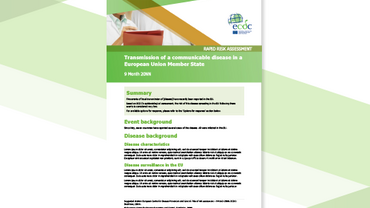Rapid Risk Assessment: Outbreak of Ebola virus disease in West Africa - Fifth update, 29 September 2014
Following an increase in the number of cases of Ebola virus disease being recorded in West Africa, ECDC has updated its risk assessment and presents options for prevention and control of the disease for European citizens.
Note to readers: a new version of this Risk Assessment was published on 6 October 2014, clarifying legend and sources on Figure 4 (page 9).
Executive Summary
Since December 2013 and as of 23 September 2014, 6 573 cases of Ebola virus disease (EVD), including 3 091 deaths have been reported by the World Health Organization (WHO) in affected countries (Guinea, Liberia, Sierra Leone and Nigeria). On 29 August, the Ministry of Health in Senegal reported a confirmed case of EVD in a 21year-old male who recently arrived from Guinea. No local transmission of EVD is currently reported in Senegal therefore the country is not among the list of affected countries to date. Transmission in the capital cities is of particular concern, owing to their population density and the repercussions for travel and trade.
Recently published projections produced by the different models of the outbreak all indicate a dramatic increasing trend in Guinea, Liberia and Sierra Leone in the coming months. These projections should be regarded as indicative of possible trends and not as exact predictions. Yet, all models point to a substantial increase in the number of cases if control efforts remain unchanged.
The evolving outbreak of EVD over the last weeks increases the likelihood that residents and travellers to the EVD-affected countries will be exposed to infected or ill persons. The risk of infection for residents and visitors to the affected countries through exposure in the community is considered low if they adhere to the recommended precautions.
People visiting friends and relatives in the affected countries tend to have more and closer contacts in the community, and they are more likely than other visitors to participate in burial ceremonies – an activity known to be associated with transmission of the Ebola virus.
Residents and visitors to the affected areas run a high risk of exposure to EVD in healthcare facilities. The risk of being exposed to the Ebola virus is higher for healthcare workers, e.g. volunteers from NGOs who work in settings where appropriate infection control measures have not been implemented.
Risk of importation to the EU is linked to the number of patients presenting with symptoms and seeking medical attention in the EU.
The risk of Ebola viruses spreading from an EVD patient who arrives in the EU as result of a planned medical evacuation is considered extremely low. If a symptomatic case of EVD presents in an EU Member State, secondary transmission to caregivers in the family and in healthcare facilities cannot be ruled out. Once the possibility of EVD has been recognised and, healthcare providers have taken precautions to stop transmission, the risk of spread is reduced to a minimum.





